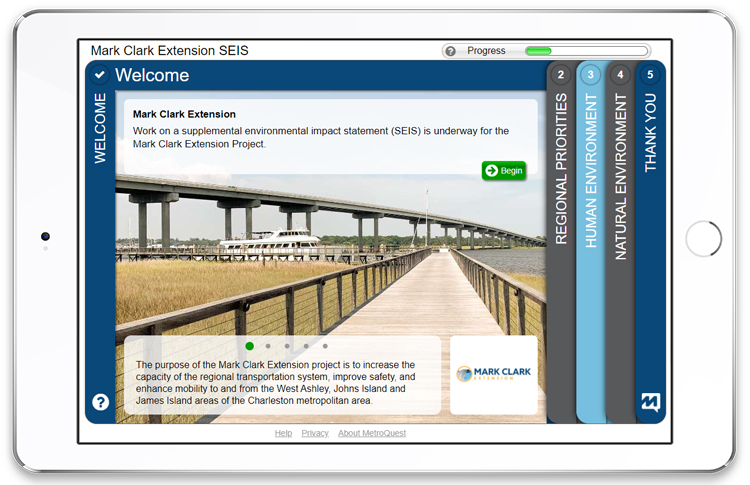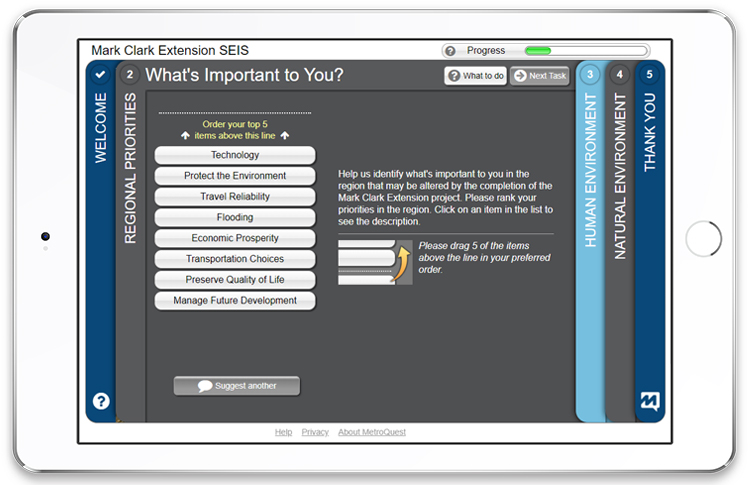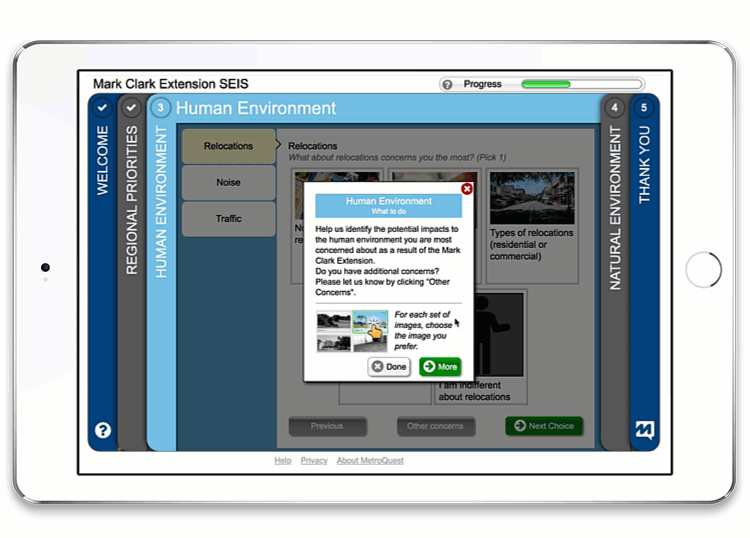[SURVEY OF THE MONTH] Mark Clark Extension SEIS – Using Online Surveys as Part of a Decision-Making Process
![Mark Clark Extension SEIS – Using Online Surveys as Part of a Decision-Making Process [SURVEY OF THE MONTH] Mark Clark Extension SEIS – Using Online Surveys as Part of a Decision-Making Process](https://metroquest.com/wp-content/uploads/Mark-Clark-Extension-SEIS-–-Using-Online-Surveys-as-Part-of-a-Decision-Making-Process.png)
6 months ago, we introduced the Survey of the Month blog: a particularly great example of a MetroQuest survey created by one of our customers. We’re excited to share the takeaways to help with your next public engagement survey! While MetroQuest subscribers have no shortage of great public engagement surveys of all plans and project types, this month we are presenting a fantastic example of how MetroQuest can be used to assist in the decision-making process and help meet federally legislated requirements.
The Mark Clark Extension supplemental environmental impact statement survey (SEIS) is a perfect example of utilizing MetroQuest to help meet requirements to move a project forward, turning complex content into an engaging and straightforward survey that participants can easily respond to.
What’s the story? Mark Clark Extension SEIS
The Mark Clark Extension (MCX) is a corridor project in Charleston, South Carolina. The goal of the project is to increase the capacity of the regional transportation system while improving safety and mobility. As this project has first been envisioned 50 years ago, a supplemental environmental impact statement (SEIS) is required to move the project along now because the Federal Highway Administration (FHWA) has determined that significant enough changes have occurred in the project’s concept or affected environments due to its time span.
To help move the process along, the South Carolina Department of Transportation (SCDOT), a MetroQuest customer, chose MetroQuest’s online surveys as a tool to help complete the FHWA requirements and over 1,500 people participated!
For more information on the project, please visit https://www.scdotmarkclark.com/.
Anatomy of a SEIS Survey: Using MetroQuest for a supplemental environmental impact statement
While federally mandated regulations are common requirements for planners, they contain complex material to convey to the layman who is typically the audience of public engagement. SCDOT has done a fantastic job turning the SEIS study into a very straight-forward survey that is fun and engaging.
The survey starts by presenting background information on the MCX as well as the SEIS. This includes several sliders providing context around the study and explaining the SEIS in simple terms, which helps participants understand the importance of their input. Then, on a Priority Ranking Screen, the survey presents eight regional priorities, namely Transportation Choices, Travel Reliability, Flooding, Technology, Manage Future Development, Preserve Quality of Life and Economic Prosperity. The task for participants is to choose their top five, indicating to SCDOT what elements participants consider to be the most important.
Two Visual Preference Screens follow. The use of the same screen to cover two aspects of the SEIS is very clever and effective on the part of the MCX Team! The first screen covers the human environment, and the second is on the natural environment. Participants are asked to help identify the potential impacts, to human and natural environment respectively, that they are most concerned about. By using the same screen and covering different related elements, the survey prompts participants to provide feedback on the comparable environments in an organized and productive way. The former asks about Relocations, Noise, and Traffic, while the latter asks about Wetlands, Protected Species, as well as Fish and Wildlife. On both Screens, each asked participants for their greatest concern, with each of the possible answers represented with a clickable image.
If you’d like to try the survey, click here. This is a demo version that will not affect the survey results.
5 Tips from the Mark Clark Extension: Using MetroQuest to Complete SEIS Requirements
While the project and its contents may be complex, the survey is not. Quite the opposite, the survey is very straightforward and engaging due to the use of images and simple language. Below are five takeaways from the survey:
- As the saying goes, “a picture is worth a thousand words”. That is certainly true whenever a complex topic is presented to the public who may have little understanding of the jargon and specifics of the project. As an image can convey multiple ideas and complicated meaning, thoughtfully chosen images allow participants to access complicated materials.
- In this survey, one of the options in each category is “I am indifferent about X”. This is valuable information as well! Providing participants with a ‘none of these’ option will allow you to get a better sense of how the community values—or doesn’t value—certain aspects of the plan.
- To help make confusing material more easily understood, break the information down into bite-sized content, such as presenting subcategories on “human environment”. Also use simple language to accompany images!
- Another aspect done well in the survey is that the team kept the questions to a minimum. We often say “only ask what you really want to know” and while this might sound obvious, it’s easy to forget that participants may experience survey fatigue and do not have the same attention span online as they might have in-person at a facilitated meeting. The flip side of that is that an online survey only takes a few minutes, which allows you to reach many more people who wouldn’t take the time to attend a meeting!
- Agencies have a large number of mandates for projects and many require public engagement. The use of MetroQuest for public engagement on a very specific requirement like an SEIS is a fantastic idea to ensure that the public gets engaged in a fun way while also gathering meaningful data to help complete requirements and push projects forward.
We are thrilled that SCDOT has had great success using MetroQuest on this project. Congratulations on an incredibly well-executed survey!
For more great tips on how to make the most out of MetroQuest, contact your Customer Experience manager or reach out for more information!
Want to learn more about how MetroQuest supports community outreach on your next transportation plan when public meetings are off the table? Check out our recent webinar:
Winning Tactics for Community Engagement in the New Normal
Agencies and firms have turned to online tools to capture public opinion safely and effectively on a wider scale. Join our panel from South Carolina DOT, CDM Smith and LURA Consulting to uncover strategies behind some of this summer’s most successful public engagement projects!



